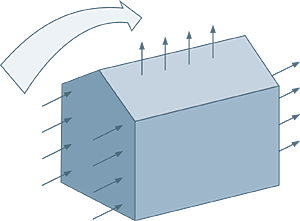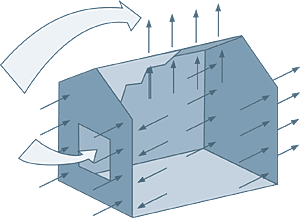Exploring the High-Performance Benefits of Laminated Glass
Natural Disaster Protection
Laminated glass provides excellent protection against hurricanes and seismic conditions.
Hurricane Protection
The massive destruction of property and buildings from hurricanes has tragically emphasized the importance of hurricane-resistant building methods and codes. Experience has shown that structures built to certain minimum wind-borne debris and impact standards can successfully withstand a strong hurricane, while structures not built to certain minimum requirements are often severely damaged. Combined with other structural safety measures, the use of laminated glazing can be critical to a building remaining intact after a hurricane. There were numerous examples of hurricane-resistant windows performing well following Hurricanes Charley of 2004, and Katrina, Rita and Wilma of 2005.
|
Glass windows and doors tend to be some of the weakest points of a building. Left unprotected, they can be shattered by hurricane-force winds and flying debris. If the building envelope is breached, wind enters the building, causing a dramatic increase in internal pressure. Internal pressure, coupled with the external pressure on the structure, can effectively double forces to lift the roof and exert pressure on the outside walls, causing structural failure. Thus, if glazed openings are penetrated, severe structural damage or complete structural destruction often occurs.
Even if severe structural damage is avoided, broken windows and doors allow wind and water to enter a building, which can completely destroy a building's contents. In the case of a residential structure, even if a house is left standing, everything that makes that house a home may be destroyed, and mold becomes a serious issue.
|
The Dan M. Russell Jr. United States Federal Courthouse in Gulfport, Mississippi, designed by R.M.Kliment + Frances Halsband Architects, weathered Hurricane Katrina in August 2005. Situated between Biloxi and New Orleans, Gulfport faced extreme winds and hurricane conditions when Katrina struck. The eight-story federal courthouse, situated yards from the Gulf of Mexico, features a concrete exterior punctuated by large expanses of glass, which allows occupants to enjoy natural light and ocean views. In order to provide protection against hurricanes and address security and energy-efficient design criteria, insulating laminated glazing with a low-e coating was used throughout the project, in windows, curtain walls, and overhead glazing. Thanks to this careful planning and construction and laminated glass protection, the courthouse survived the storm intact.
As a result of the many hurricanes and ensuing property damage that has impacted Florida, the state has aggressively pursued rigorous hurricane-related building standards, and has building codes that are among the most stringent in the world. However, glazing standards outside Florida are not as stringent, and even nonexistent, in many coastal areas, which may have contributed to the devastation in Louisiana, Mississippi, and Alabama during the 2005 hurricane season. In fact, a Louisiana State University (LSU) Hurricane Center study presented by Center Director Dr. Marc Levitan estimated that the implementation of mitigation measures including opening protection, improved roof sheathing attachment, hurricane straps and clips, and secondary moisture protection could have reduced estimated residential wind losses during Hurricane Katrina by more than 75 percent.
In recent years, laminated glass has emerged as one of the best measures of glazed opening protection against hurricanes. Because of the tough interlayer, laminated glass may crack if impacted by debris and hurricane-force winds, but the fragments adhere to the interlayer, preserving the building envelope and eliminating flying glass. Commercial and residential window and door systems must meet various impact, windborne debris, and cyclic wind pressure tests in order to satisfy hurricane-related building codes. The test procedures call for the entire assenbly of the glass and glazing system to meet protocol. Depending on the distance above grade, the assembly is either subjected to the large missile or small missile impact test, followed by pressure cycling.












